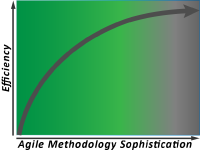The post Marketing Project Management Software vs. Generic Project Management Software appeared first on Markodojo - Marketing Management Software - Agile Marketing.
]]> Generic project management software is good for a wide variety of projects. That is exactly why it falls short for marketing project management. Generic project management software is, well, generic. Marketing project management software should focus on the way marketing teams and marketing projects work. To fully optimize marketing, project management software must focus on the unique needs of marketing, rather than be a one size fit all solution for everyone from building contractors to NASA. Below, we examine 5 key areas where marketing project management software should address the project structures, flow, tracking and sharing needs common in marketing organizations.
Generic project management software is good for a wide variety of projects. That is exactly why it falls short for marketing project management. Generic project management software is, well, generic. Marketing project management software should focus on the way marketing teams and marketing projects work. To fully optimize marketing, project management software must focus on the unique needs of marketing, rather than be a one size fit all solution for everyone from building contractors to NASA. Below, we examine 5 key areas where marketing project management software should address the project structures, flow, tracking and sharing needs common in marketing organizations.
“Marketing’s needs go well beyond the lowest common denominator capabilities of generic project management software.”
Marketing Project Management Software Requirement #1
Deep and Complex, Not Shallow and Simple
True for marketers, but even more true for marketing projects. Marketing projects range from a simple blog post to a large product launch. If you’re only tracking tasks for publishing a blog post, generic project management software will easily fit the bill. Marketing project management software has to accommodate the greater depth and complexity of most marketing projects, including something as complex as a product launch.
First, marketing project management software must address an unknown level of projects and sub projects. For instance, a product launch may have sub projects related to advertising, PR, events and so forth. Within those sub projects, say advertising, you may have on-line, print and media advertising. Within media advertising you may create further sub projects for radio and television. And so on, and so on. You may also want to later move sub projects around from one parent project to another, or move them up or down levels. This is simply how marketing projects work, and it’s how marketing project management software should work, too.
In project management speak, marketing project management software must provide an unbounded and flexible hierarchy model. It must accommodate an unlimited level of projects and sub projects, not just a couple of levels or one long list of tasks. It must allow you to move projects around, both horizontally and vertically, at any point in the hierarchy. In general, your marketing project management software hierarchy model must be highly flexible, because marketing projects are not shallow and simple.
Marketing Project Management Software Requirement #2
Marketing Project Teams Vary Wildly
There’s no model for how to construct a team for a marketing project. The team could consist of people from within marketing, colleagues from other parts of the company, and outside staff from agencies or contractors. Marketing project management software must handle the array of challenges these varying teams present.
Take our product launch, for example. We may want everyone in marketing to see, collaborate and comment on everything related to the launch. However, we might want colleagues from product or sales to see everything, but only collaborate on select parts of the launch project, say product literature. Then we have outside people, like a design contractor who needs to work with the team on product literature graphics, but shouldn’t see anything else.
Generic project management software handles basic privileges, but stumbles with managing a complex mix. Marketing project management software must mix and match visibility and collaboration privileges (meaning a mix of create, read, and update capability) on a person by person, project by project basis. Otherwise, your marketing team is forced to work around your project management software, or only use it with certain types of projects or people. Clearly, that’s not a good option.
Marketing Project Management Software Requirement #3
From Ideas to Projects
So far, we’ve only talked about projects. Projects are where we typically think of the work happening. But that’s only part of the marketing project work flow. Our marketing project management software should be able to handle the whole project process.
The first part of the marketing project process starts with ideas. After vetting and prioritization, ideas become tomorrow’s projects. How does generic project management software handle ideas? It doesn’t. Unlike marketing, most business operations that need project management software don’t constantly brainstorm and innovate the same way as marketing. So, generic project management software starts (and ends) with the project, and ignores ideas. That’s not bad, it just doesn’t fit marketing.
Marketing project management software must track and manage ideas, because they are a core part of marketing project flow. Let’s look at our product launch again. The activities and content for the launch are not laid out like a blueprint for a building. From deciding what channels to employ to the details of specific messaging, running the launch starts with collecting, grooming and prioritizing ideas. The best ideas, balanced against resources, become active projects. When those projects complete, the process repeats until the launch is done. Most marketing projects follow this flow. Ideas are a crucial part of that flow. We need to track and manage them, as well as share with colleagues what ideas were considered, how they were prioritized, and which are planned for execution. If our marketing project management software does not track and manage ideas, then we fail to optimize an important part of the marketing process.
Marketing Project Management Software Requirement #4
From Projects to Results
Just as marketing projects begin with ideas, marketing projects end with results (we hope). Generic project management software manages tasks and schedules, but not results. This is fine for construction, but not for marketing. Some marketing results exist in marketing automation or advertising systems, but they are not tied back to the project details that drove them. Marketing project management software must help track and tie results to projects.
Lets take our product launch again. The high level goal may be leads or sales for the new product. Certainly, its important to track these. Its also important to track results for the launch sub projects. Attendees at events, downloads of product information, email opens, etc., are good examples. Recording these metrics with their projects is the basis for learning. Referring to the details of previous projects and outcomes helps improve future projects. Without the record of project details and results, you are likely to fall prey to your favorite proverb about forgetting history and being doomed to repeat it. Recording results with related project details is a valuable way to continuously improve marketing projects and outcomes.
Marketing Project Management Software Requirement #5
Marketing Likes to Share
Lastly, marketers need to keep everyone up to date on their project plans, activities and results. Generic project management software again falls short, as it tends to focus only on the project team. This means that marketing is forced to share information via spreadsheets and presentations (which always seem to be out of date).
Good marketing project management software shouldn’t stop with the project team. With the necessary project data already at hand, it should share information automatically. Roadmaps, project statuses, and project results should be shared with executives, sales and product teams who will always see real-time information. Rather than continuously chasing data and updating spreadsheets, marketing should be freed to spend more cycles driving results.
Tailored for Marketing, Not One Size Fits All
 Generic project management software covers part of marketing’s needs. It leaves other needs unaddressed. This is understandable, because marketing’s needs go well beyond the lowest common denominator capabilities of generic project management software. Marketing project management software has emerged to specifically address the unique combination of requirements required to properly optimize marketing teams and their work. Generic options are better than nothing, but can’t compare to the tailored benefits of true marketing project management software.
Generic project management software covers part of marketing’s needs. It leaves other needs unaddressed. This is understandable, because marketing’s needs go well beyond the lowest common denominator capabilities of generic project management software. Marketing project management software has emerged to specifically address the unique combination of requirements required to properly optimize marketing teams and their work. Generic options are better than nothing, but can’t compare to the tailored benefits of true marketing project management software.
The post Marketing Project Management Software vs. Generic Project Management Software appeared first on Markodojo - Marketing Management Software - Agile Marketing.
]]>The post Adopting Agile Marketing | Take an Easier Path appeared first on Markodojo - Marketing Management Software - Agile Marketing.
]]> Adopting agile marketing doesn’t need to be a traumatic, seismic shift for your marketing group. Don’t worry about deep diving into complex methodologies, or duplicating the practices of agile development. Agile marketing is foremost a mentality and a culture based on flexibility, speed, true customer value, and openness. The methodology you choose is secondary. So, start you agile marketing journey in small, simple steps. First, adopt the core disciplines of agile marketing. Then, apply some basic agile processes, see how they work, adapt them, and iterate.
Adopting agile marketing doesn’t need to be a traumatic, seismic shift for your marketing group. Don’t worry about deep diving into complex methodologies, or duplicating the practices of agile development. Agile marketing is foremost a mentality and a culture based on flexibility, speed, true customer value, and openness. The methodology you choose is secondary. So, start you agile marketing journey in small, simple steps. First, adopt the core disciplines of agile marketing. Then, apply some basic agile processes, see how they work, adapt them, and iterate.
In other words, the best approach to adopting agile marketing is an agile approach!
“The best agile methodology is the one that fits your team, not a preconceived recipe you have to follow.”
Focus First on Agile Marketing Disciplines
The biggest benefit from adopting agile marketing comes from applying core agile disciplines. These disciplines are the foundation for improved efficiency, output and alignment, no matter what agile process you implement.
The core agile marketing disciplines are:
- Measure value through the eyes of the customer. Whether you like a program is irrelevant — you are not the customer. Measure success only through real results and real feedback from real customers.
- Minimize waste by managing uncertainty. Work on the things you can do today that will produce real customer value. Be open, clear and realistic about what you are doing when.
- Maximize flexibility by working incrementally. Break big projects into smaller, manageable sub projects, so you can measure and adjust early, and recognize and remove barriers as soon as possible.
- Foster alignment and collaboration through transparency. Broadly sharing information about plans, projects and results creates understanding and alignment, and encourages input.
- Improve incrementally and continuously. Plan, do, check, act — in small increments. Don’t be afraid to fail, just don’t fail the same way multiple times. Learn as quickly as possible, improve, and iterate.
(To learn more about agile marketing disciplines, check out the ebook agile marketing disciplines)
It’s important to make these disciplines a part of your marketing culture. Discuss and debate them with your team. If your team understands the basics of these disciplines and applies them, you can be successful with a wide range of agile processes.
Building those processes is your next step.
Start with Basic Agile Marketing Processes
 The key to successfully adopting agile marketing is to get just enough process in place to support your agile disciplines. Then, adjust the process to best fit your team. No agile methodology is right, or wrong. You may have heard of Scrum, Kanban, Lean and other agile methodologies, which have been borrowed from agile manufacturing and development, and applied to agile marketing. They may be ideal for your team, but they may also be too complex and intimidating as a whole. A simpler, easier path to adopting agile marketing is to start with some basics processes that you can quickly adopt, then evolve into a methodology that works well for you. The best agile methodology is the one that fits your team, not a preconceived recipe you have to follow.
The key to successfully adopting agile marketing is to get just enough process in place to support your agile disciplines. Then, adjust the process to best fit your team. No agile methodology is right, or wrong. You may have heard of Scrum, Kanban, Lean and other agile methodologies, which have been borrowed from agile manufacturing and development, and applied to agile marketing. They may be ideal for your team, but they may also be too complex and intimidating as a whole. A simpler, easier path to adopting agile marketing is to start with some basics processes that you can quickly adopt, then evolve into a methodology that works well for you. The best agile methodology is the one that fits your team, not a preconceived recipe you have to follow.
To get started, here are some basic agile processes to consider. Try these, then adapt and expand them to fit your team.
✓ Agile Basic 1 | Create and Publicize a Backlog
Create a prioritized backlog that specifies what you will, and will not be working on (a great basic from Scrum).
First, make sure everyone understands each item. Any item that is unclear should sit at the bottom of your backlog until it is clear. Then, (mimicking a key part of Lean), rate and prioritize each idea along two dimensions: 1) the customer value it will create and 2) the amount of work involved.
Now, make sure everyone can see your prioritized backlog. No magic here. Share the list on your intranet, tape it to a wall, or use an app that shares your work with everyone – whatever works for you. Make sure everyone can see the list, because alignment and collaboration start with visibility of what your marketing team are, and are not, doing.
✓ Agile Basic 2 | Establish Defined Periods of Work
Bound and limit periods of work to create focus and increase productivity.
Create a defined period of time (called a “sprint” in Scrum), and choose projects from your prioritized back log to complete during that timeframe. Make the timeframe reasonably short, say two weeks, and don’t stretch it to fit more projects — you can get to them in the next sprint. It’s important to define a limited sprint, because it gives your team a clear end point by which to complete a specific set of projects. This allows your team to focus on those, and only those, projects assigned to that sprint.
Switching costs are a major cause of wasted cycles. So, be diligent about not adding new projects mid sprint. This may cause heartburn with colleagues who are used to asking for emergency projects. But in the long run, making your team more efficient will benefit everyone, so stick to your sprint plan.
✓ Agile Basic 3 | Break Big Projects into Small Projects
Divide all projects longer than one week into sub projects no more than one week (shorter wherever you can), and turn all unbounded work into bounded steps whenever possible.
Estimating work for big projects is rarely accurate, and commonly leads to missed dates, wasted cycles and stressed team members. When you break big projects into small projects, the work becomes more manageable, and predictable. Progress is more easily measured and monitored with small projects. If problems arise with a small project, you can take palliative steps when it’s only days late, instead of trying to fix a big project that is a month late. Smaller projects also create the opportunity to test earlier, and make corrections before follow-on work is done, eliminating wasteful rework (a basic adapted from Lean methodology).
Similarly, unbounded work is hard to manage. Many projects in marketing rely on creativity, where it is difficult to dictate bounded time frames. So, don’t try. Instead, find ways to define bounded steps in the process, like delivering first and second drafts within specific time limits. The total effort and endpoint of a big creative project may be unknowable, but you can start with and manage smaller checkpoints.
Work everything in manageable increments. Check and test as early as possible — and create opportunities for early improvement.
✓ Agile Basic 4 | Test Early with Real Customers
Focus on driving results with real customers above solely meeting project specifications.
This may seem academic, but is not practiced enough. If a marketing project meets all the requirements specified by its owner, can it be labeled a success? No. It can only be labeled a success if it drives the impact for which it was intended. For instance, is it more important to deliver email content that the team likes, or that drives prospect conversions?
Team input is valuable, but prospect or customer input is critical. Test outlines with your target audience before writing the full copy. Use A / B testing when developing new themes. Monitor sentiment on social media. Although it’s often difficult, the key point is to test with customers or prospects whenever and as early as possible to measure real reactions. Then, adjust according to the data and feedback. Everyone involved will be much happier with customer success than with perfect adherence to specifications.
✓ Agile Basic 5 | Run Regular Heartbeat Meetings
Create a regular cadence of communication and involvement.
“Stand-up meetings” (as they are called in Scrum and Kanban) are a great example. These are short meetings where the participants literally stand while briefly discussing what they have accomplished, what they are doing next, and any barriers they face. The meetings should be regular, held either daily or two to three times per week, and should be short and focused. Each team member contributes their brief update, and only their update. Topics requiring additional discussion should be saved for other meetings with only the necessary participants, not the whole team.
Regular stand ups expose barriers early, and reinforce the drive to complete projects. Who wants to repeatedly report to their colleagues that they have no progress to report, right?
✓ Agile Basic 6 | Share Everything
Make broadly sharing information a core part of your process.
Sharing information with others is foundational to agile success. Beyond sharing your backlog as discussed above, you should also share sprint progress (called a burn-down), sprint barriers, project performance metrics and team member assignments. Publishing information keeps others up to date, and also produces other big benefits.
Sharing aids alignment. When you share and encourage commentary on plans and problems, others become invested in, and aligned with, your efforts. Sharing also stimulates collaboration. Visibility of plans, problems and ideas in a workgroup is clearly critical to collaboration. But, sharing the same information beyond the workgroup can produce solutions and options that might be missed.
Whether you update an intranet or a whiteboard, or use a tool designed to automatically share your work, make sharing information a mandatory part of your process. And, when in doubt, opt to share more rather than less.
Adopting Agile Marketing on Your Own Path, Step by Step
 The basic agile processes and the agile disciplines above will give you a great start when adopting agile marketing. You may be pleasantly shocked at the increased efficiency gained from just this simple start.
The basic agile processes and the agile disciplines above will give you a great start when adopting agile marketing. You may be pleasantly shocked at the increased efficiency gained from just this simple start.
Is this all there is to agile marketing? Unquestionably, no. There are many other suggested processes. But, there is no prescribed methodology that you must follow to benefit from adopting agile marketing. As I led with, agile marketing is foremost a mentality and a culture based on flexibility, speed, true customer value and openness. So, choose your own simple steps to ease into agile. Try what you like from the basics above, or other processes. Test them. Learn from the results and improve. That is a successful method for adopting agile marketing. After all, it’s the agile way!
The post Adopting Agile Marketing | Take an Easier Path appeared first on Markodojo - Marketing Management Software - Agile Marketing.
]]>